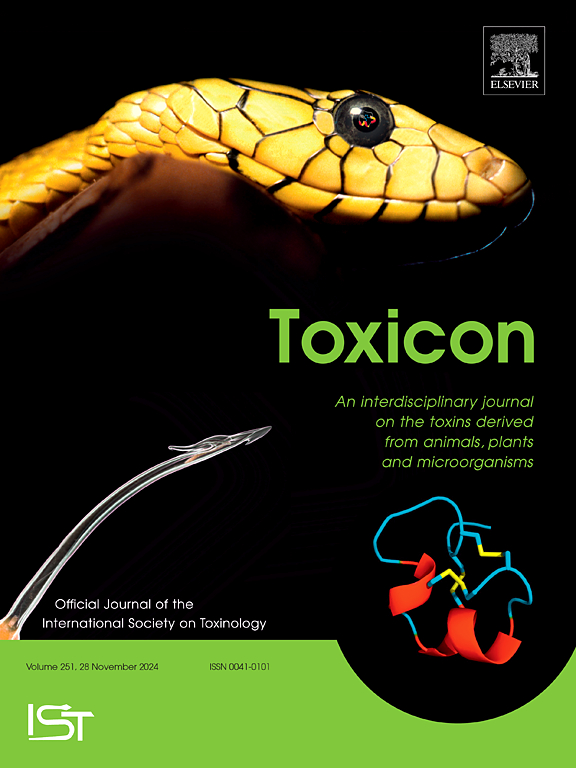Analytical quantification of the plant specific cardiac glycosides in biological fluids in a rare case of yellow oleander (Cascabela thevetia) self-poisoning in Italy
IF 2.6
4区 医学
Q2 PHARMACOLOGY & PHARMACY
引用次数: 0
Abstract
Yellow oleander contains digoxin-like cardiac glycosides that frequently cause intoxications in Sri Lanka and India. To date, though, no exposure has been analytically confirmed and quantitative determination of the plant specific glycosides in human biological fluids was never performed. We report an unusual case of self-poisoning in a young female in Italy who ingested 9 crushed seeds of Cascabela thevetia and was admitted to the emergency room with a 2nd degree atrio-ventricular block at the ECG. The case was managed with activated charcoal, repeated doses of anti-digoxin immune Fab and supportive care. A transient thrombocytopenia developed and resolved within a few days. Ultra-high performance liquid chromatography coupled with tandem mass spectrometry was used for the determination and quantification of thevetin A, thevetin B and peruvoside in plasma and urine. Thevetin A and thevetin B, two of the primary glycosides in the seeds, were not present in any of the samples, while detectable levels of the metabolite peruvoside were found in all biological samples on day 1 and 3. Digitoxigenin, the aglycone of thevetin B, was also identified using a semi-untargeted analysis. This is the first report of a quantitative determination of cardiac glycosides of yellow oleander in blood and urine. The finding may support very early administration of activated charcoal to possibly prevent further formation of secondary, and possibly more potent, glycosides and limit toxicity.

意大利罕见黄夹竹桃(Cascabela thevetia)自中毒病例生物液中植物特异性心苷的分析定量。
黄夹竹桃含有地高辛类心脏糖苷,在斯里兰卡和印度经常引起中毒。但迄今为止,没有分析证实暴露,也从未对人体生物体液中的植物特异性糖苷进行定量测定。我们报告了一例不寻常的自我中毒病例,在意大利,一名年轻女性摄入了9粒压碎的番薯种子,并因心电图显示二度房室传导阻滞而被送入急诊室。该病例采用活性炭、重复剂量抗地高辛免疫Fab和支持性护理进行治疗。短暂性血小板减少症在几天内消失。采用超高效液相色谱-串联质谱联用技术对血浆和尿液中的黄花素A、黄花素B和紫花苷进行了定量测定。在所有样品中都不存在种子中的两种主要苷——黄素A和黄素B,而在第1天和第3天,在所有生物样品中都发现了可检测到的代谢产物黄素苷。洋地黄苷元,黄芪黄素B的苷元,也用半非靶向分析鉴定。本文首次报道了血和尿中黄夹竹桃心苷的定量测定。这一发现可能支持早期施用活性炭可能防止进一步形成次生的,可能更有效的,糖苷和限制毒性。
本文章由计算机程序翻译,如有差异,请以英文原文为准。
求助全文
约1分钟内获得全文
求助全文
来源期刊

Toxicon
医学-毒理学
CiteScore
4.80
自引率
10.70%
发文量
358
审稿时长
68 days
期刊介绍:
Toxicon has an open access mirror Toxicon: X, sharing the same aims and scope, editorial team, submission system and rigorous peer review. An introductory offer Toxicon: X - full waiver of the Open Access fee.
Toxicon''s "aims and scope" are to publish:
-articles containing the results of original research on problems related to toxins derived from animals, plants and microorganisms
-papers on novel findings related to the chemical, pharmacological, toxicological, and immunological properties of natural toxins
-molecular biological studies of toxins and other genes from poisonous and venomous organisms that advance understanding of the role or function of toxins
-clinical observations on poisoning and envenoming where a new therapeutic principle has been proposed or a decidedly superior clinical result has been obtained.
-material on the use of toxins as tools in studying biological processes and material on subjects related to venom and antivenom problems.
-articles on the translational application of toxins, for example as drugs and insecticides
-epidemiological studies on envenoming or poisoning, so long as they highlight a previously unrecognised medical problem or provide insight into the prevention or medical treatment of envenoming or poisoning. Retrospective surveys of hospital records, especially those lacking species identification, will not be considered for publication. Properly designed prospective community-based surveys are strongly encouraged.
-articles describing well-known activities of venoms, such as antibacterial, anticancer, and analgesic activities of arachnid venoms, without any attempt to define the mechanism of action or purify the active component, will not be considered for publication in Toxicon.
-review articles on problems related to toxinology.
To encourage the exchange of ideas, sections of the journal may be devoted to Short Communications, Letters to the Editor and activities of the affiliated societies.
 求助内容:
求助内容: 应助结果提醒方式:
应助结果提醒方式:


